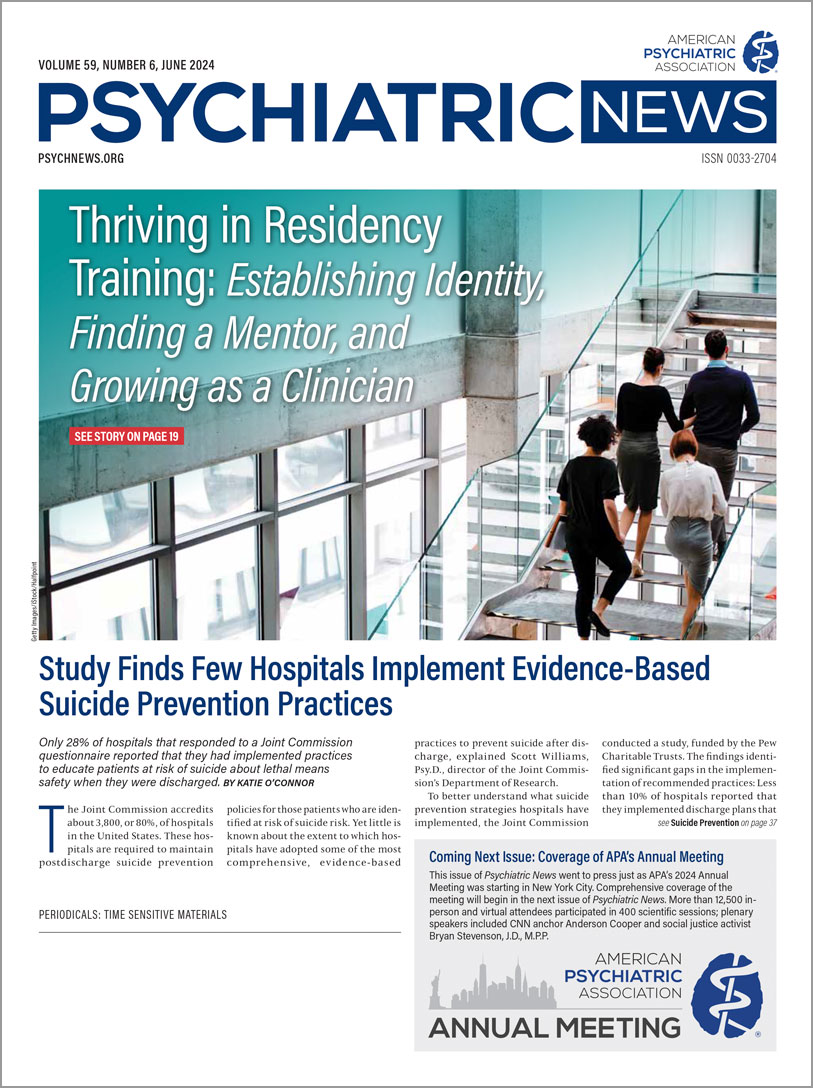The Joint Commission accredits about 3,800, or 80%, of hospitals in the United States. These hospitals are required to maintain postdischarge suicide prevention policies for patients who are identified at risk of suicide. Yet little is known about the extent to which hospitals have adopted some of the most comprehensive, evidence-based practices to prevent suicide after discharge, explained Scott Williams, Psy.D., director of the Joint Commission’s Department of Research.
To better understand what suicide prevention strategies hospitals have implemented, the Joint Commission conducted a study, funded by the Pew Charitable Trusts. The findings identified significant gaps in the implementation of recommended practices: Less than 10% of hospitals reported that they implemented discharge plans that include all recommended suicide prevention practices and components of formal safety planning included in the study. The
findings were published in
The Joint Commission Journal on Quality and Patient Safety.
“While I am not surprised by the results, I nonetheless think the findings are quite important,” Mark Olfson, M.D., M.P.H., who was not involved in the study, told Psychiatric News. “They will hopefully motivate policymakers to strengthen accreditation standards in this area and persuade hospitals to invest in efforts to help keep their high-risk inpatients safe during the period following hospital discharge.” Olfson is the Elizabeth K. Dollard Professor of Psychiatry, Medicine, and Law at the Columbia University Irving Medical Center and a research psychiatrist at the New York State Psychiatric Institute.
To conduct the study, Williams and colleagues surveyed Joint Commission-accredited hospitals (including medical/surgical, acute care, psychiatric, and children’s hospitals). They included hospitals that received accreditation from 2020 to 2021 and excluded those with a specialty focus, such as rehabilitation hospitals.
With the input of an expert panel, the authors identified four recommended practices that hospitals could implement prior to discharge to help prevent suicide once patients leave the hospital: formal safety planning, planning for lethal means safety, providing warm handoffs to outpatient care, and making follow-up contact after discharge.
These prevention practices, if properly implemented, can help support high-risk patients as they transition from inpatient to community care, Williams said. Safety planning gives people coping strategies and resources to better deal with suicidal crises; planning for lethal means safety helps align patient preferences with safe behaviors; warm handoffs can reduce no-shows for people entering care with new clinicians; and follow-up contacts can help connect people to outpatient care who might otherwise fall through the cracks, he explained.
On the surveys, hospitals were asked if they had implemented suicide prevention practices with patients at time of discharge and had the option to reply with a yes or no. They were then specifically asked about certain key components of the four recommended practices to determine if hospitals had implemented them. For example, they were asked about eight key components of formal safety planning, such as documenting internal coping strategies and identifying personal contacts to ask for help. To be counted as having implemented the suicide prevention practices, the hospitals had to report implementing the practices themselves as well as all the practice components.
Though 1,148 hospitals were surveyed, 346 responded. Most (61%) reported implementing formal safety planning, but only 19% of these included all key components. A third of hospitals provided a warm handoff to outpatient care (37%) or made follow-up contact with patients after discharge (30%). Only 4% of hospitals met the full criteria for implementing all the recommended suicide prevention practices at the time of discharge.
More than 55% of the hospitals that reported practicing safety planning were not addressing lethal means safety. Olfson said he found this finding to be especially disconcerting. “Given that firearms are the most common method of suicide in the United States and evidence that lethal means safety planning lowers risks, it is worrisome that only one-quarter (28%) of hospitals report developing a plan for lethal means safety for their high-risk patients,” he said.
The authors noted that none of the practices included in the study are required for Joint Commission accreditation. Hospitals are required only to develop policies for follow-up care for patients at risk, but the requirement does not specify what interventions should be used. They wrote that the study’s findings suggest that hospitals are meeting the requirement through practices that require minimal resources and may be less effective, like making referrals and providing patients with a list of community crisis resources.
Implementing evidence-based suicide prevention strategies in health care systems can be challenging, but patients and their families should expect, and deserve to receive, quality care, said Julie Goldstein Grumet, Ph.D., director of the Zero Suicide Institute. Health care professionals have a lot of responsibilities and a limited time to complete them, she said. Many are not trained to use best practices.
“Just because you hold a license in social work, psychology, counseling, psychiatry, or nursing doesn’t mean you have received a lot of specific training on suicide care and interventions,” she said. “We know from research that people are not getting the necessary training.”
Further, stigma and misconceptions about mental illness generally may limit the efficacy of these interventions even when they are implemented, Goldstein Grumet added.
“Setting up a screening question, for example, by saying ‘I’m sorry, but I have to ask you this question,’ is telling the person at risk that the provider is uncomfortable and doesn’t know what to do if the patient screens positive,” she explained. “In health care we are often putting the responsibility on the patients at risk to come forward and tell us they’re in distress or suicidal, and that causes a lot of people to slip through the cracks.” ■

